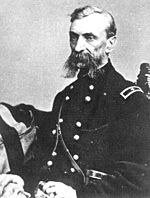Alexander Asboth facts for kids
Quick facts for kids
Alexander Asboth
|
|
|---|---|

Alexander Asboth
|
|
| Born | December 18, 1811 Keszthely, Hungary |
| Died | January 21, 1868 (aged 56) Buenos Aires, Argentina |
| Place of burial | |
| Allegiance | Kingdom of Hungary United States |
| Service/ |
Hungarian Army United States Army Union Army |
| Years of service | 1836–1849 (Hungary) 1861–1865 (USA) |
| Rank |
|
| Battles/wars | Hungarian Revolution of 1848 American Civil War |
Alexander "Sandor" Asboth (Hungarian: Asbóth Sándor, December 18, 1811 – January 21, 1868) was a Hungarian military leader. He is best known for his victories as a general for the Union Army during the American Civil War. After the war, he also served as a United States Ambassador to Argentina and United States Ambassador to Uruguay.
Contents
Early Life and Hungarian Revolution
Alexander Asboth was born in Keszthely, Hungary, on December 18, 1811. When he was eight, his family moved to Zombor (now Sombor in Serbia). Alexander wanted to be a soldier, like his older brother Lajos. However, his parents decided he should become an engineer instead.
Becoming an Engineer
Asboth studied at the Mining Academy of Selmecbánya and the Institutum Geometricum in Pest. After finishing his studies, he worked on important building projects. He helped construct the famous Széchenyi Chain Bridge. He also worked on regulating the flow of the Lower-Danube River.
Joining the Hungarian Revolution
In 1848, Asboth joined the revolutionary movement led by Lajos Kossuth. This movement aimed for Hungary's independence. In December 1848, he became a captain. He fought in battles like Kápolna and Nagysalló. By spring 1849, he was promoted to major. He then became a special assistant (adjutant) to Kossuth and reached the rank of lieutenant colonel. After the revolution failed, Asboth traveled with Kossuth to the Ottoman Empire and then to the United States in 1851.
Service in the American Civil War
Alexander Asboth stayed in the United States and joined the Union Army. In July 1861, he became the chief of staff for General John C. Frémont. President Abraham Lincoln nominated Asboth as a brigadier general on December 26, 1861. The U.S. Senate confirmed his promotion in March 1862.
Leading Troops in the West
Asboth was given command of the 4th Division in Frémont's western campaign. He later led a division under General Samuel Ryan Curtis. During the Arkansas campaign, his troops occupied Bentonville and Fayetteville. He played a part in the Battle of Pea Ridge. During this battle, his right arm was broken by a musket ball while he was bringing help to Colonel Eugene Asa Carr.
Later Commands and Injuries
After the Battle of Pea Ridge, Asboth commanded a brigade during the Siege of Corinth. He later led military bases in Kentucky and Ohio. In August 1863, Asboth was sent to the District of West Florida. His main office was at Fort Pickens. He was seriously wounded again in the Battle of Marianna on September 27, 1864. His left cheekbone was broken, and his left arm was fractured in two places.
Post-War Recognition
Asboth left the volunteer service on August 24, 1865. On January 13, 1866, President Andrew Johnson nominated him for the honorary rank of major general. This rank was given to him for his brave service. The U.S. Senate confirmed this award in March 1866.
Later Life and Legacy
In 1866, Alexander Asboth was appointed as the U.S. Minister (Ambassador) to Argentina and Uruguay. He died in Buenos Aires in 1868. His death was likely caused by the serious wounds he received in Florida during the war.
He was first buried in Buenos Aires' British cemetery. In 1923, his remains were moved when that cemetery became a park. In October 1990, his remains were brought back to the United States. He was re-buried at Arlington National Cemetery, a place of honor for many American military heroes.
See Also
- List of American Civil War generals (Union)
Images for kids


